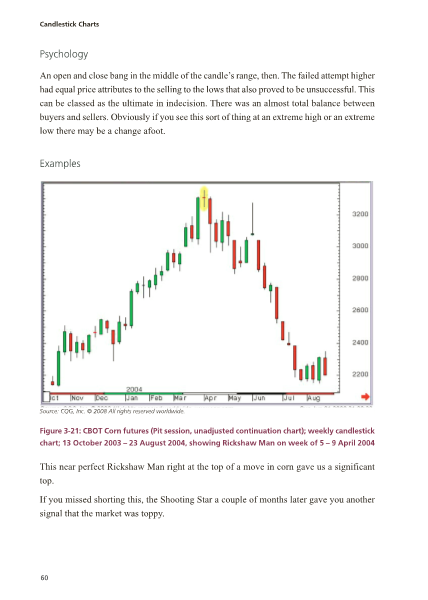Introduction to Candlestick Charting
Post on: 16 Март, 2015 No Comment

Candlestick Charting
If you are new to Candlestick charts, do not be intimidated. They use exactly the same information that is contained in more traditional bar charts: open, high, low and close. If a bar in a bar chart is worth a thousand words, however, the same information presented in a candlestick is worth 10,000 words. Were it not for the exotic names of some of the patterns and components of this charting technique, you probably would have started using candlesticks long ago. My advice, at least when first starting out, is to forget about the pattern names. Instead, concentrate on the information provided. Look at one bar (candlestick) at a time and consider what it means. Soon, I think you will see the strength this very visual charting technique offers. Perhaps you are more comfortable with the term pattern recognition. Candlesticks are a very effective method for defining such patterns.
Usually, one of the prerequisite elements of applying candlesticks is to first identify the current market trend. Many of the widely known candlestick patterns are reversal patterns. The first step to identifying a reversal is to know what you are reversing from. That makes candlesticks ideal when combined with the M asterDATA T rend C hannel I ndicator (please review the Trend Table top right corner — click on any index name in the table for a current chart including the MTCI). Candlestick patterns utilized in conjunction with the proprietary MTCI, have been highly refined beyond what you find in text books on the subject.
My purpose is not to teach candlestick charting or sell the idea of candlesticks. My purpose is only to make money. I believe candlesticks, combined with my other work, provide an incomparable tool in explicitly defining the Index and ETF Component Analysis trading program. Candlesticks are ideal when building a totally objective computer program. On the other hand, aside from an occasional mention in example charts, you will probably never hear me talk about candlesticks or their patterns. The information presented here is information I reference on occasion myself. I thought it might also be of interest or possible help to you. Patterns, however, discussed in this section are the text book definitions. Index and ETF Component Analysis defines these patterns significantly beyond what is presented here before utilizing them in the program.
WHERE DID CANDLESTICK CHARTS COME FROM?
Analysis based on trends in market psychology has its roots in Japanese rice trading in the 1700s. One of the most famous traders of the day, a man named Homma, discovered that studying the emotions of a market could be very useful in determining future trends.
Although it is not known whether Homma can be credited with developing candlestick charts as we know them today, it is under the same principles that led to their evolution and wide-spread acceptance among Eastern traders since the late 1800s. Candlestick charts have been a commonly practiced analysis technique ever since, and it is quite clear that Eastern traders have long given great weight to how market psychology effects future trading.
Dont let the Oriental mystique deter you from using candlesticks. Candlesticks are just a tool. A very good tool, but a tool. I, too, wish some of the pattern names would go away, but that is the worst of the technique. Frankly, you do not have to call any given pattern anything as long as it works and you know what it looks like.














